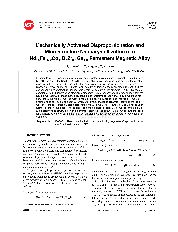摘要
In order to obtain nano-structured as-disproportionated microstructure in partially Co-substituted NdFeB-type alloys, the Nd(14)Fe(66.9)Co(11)B(7)Zr(0.1)Ga(1.0) alloy was disproportionated by room-temperature reactive ball milling in hydrogen, with the mechanical energy serving as the driving force. The reaction progress during milling was examined by hydrogen absorption measurement, and the corresponding microstructure change was characterized by X-ray diffraction (XRD), Mossbauer spectrometry, and transmission electron microscopy (TEM), respectively. The results show that the Nd(2)(Fe, Co)(14)B matrix phase in the alloy can be mechanically disproportionated by a two-stage reaction. Firstly, the Nd(2)(Fe, Co)(14)B matrix phase in the alloy is hydrogenated into Nd(2)(Fe, Co)(14)BH(x), until the value of x achieves about 2.9 when a full hydrogenation is achieved. After that, the Nd(2)(Fe, Co)(14)BH(x) phase is gradually disproportionated into alpha-Fe(Co), NdH(2.7), and (Fe, Co)(2)B phases upon further milling in hydrogen. The as-disproportionated phases NdH(2.7), (Fe, Co)(2)B, and alpha-Fe(Co), are typically nano-structured, with an average grain size of about 10 nm, which lays the basis for synthesizing nanocrystalline Nd(2)(Fe, Co)(14)B grains via a subsequent desorption-recombination treatment.
- 出版日期2009-7
- 单位哈尔滨工业大学
